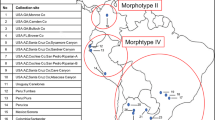Abstract
The species status of Dermacentor marginatus and Dermacentor reticulatus was evaluated by scanning electron microscope (SEM) examination of adult ticks, cross-breeding experiments and molecular biological analysis of eggs derived from transspecific pairings. The SEM investigations including the morphometric quantification of phenotypic features resulted in an unequivocal differentiation of adult D. marginatus and D. reticulatus ticks. The cross-breeding experiments demonstrated that irrespective of whether female ticks of both species were applied with con- or transspecific male ticks or without males to sheep, they engorged and laid eggs. The larvae, however, developed only in eggs which originated from conspecific matings. A nested polymerase chain reaction (PCR) of the second internal transcribed spacer (ITS2) using the DNA of eggs from transspecific pairings and sequencing of the PCR products revealed two different genotypes. The genotypes of eggs originating from D. marginatus and D. reticulatus females of these pairings differed. However, the eggs deposited by D. marginatus always possessed the same two genotypes as did the eggs produced by D. reticulatus. These results argue for a strict reproductive isolation of D. marginatus and D. reticulatus and, therefore, for a separate species status.
Similar content being viewed by others
REFERENCES
Arthur, D.R. 1960. Ticks. A Monograph of the Ixodoidea. Part V on the Genera Dermacentor, Anocentor, Cosmiomma, Boophilus & Margaropus. Cambridge University Press, Cambridge.
Babos, S. 1964. Die Zeckenfauna Mitteleuropas. Akademiai Kiado, Budapest.
Davey, R.B. and Hilburn, L.R. 1991. Reduction in egg viability resulting from infestations on cattle of hybridized Boophilus ticks and Boophilus microplus (Acari: Ixodidae) at various ratios. J. Med. Entomol. 28: 763–769.
Dias, J.A. T.S., Caeiro, V., Simoes, A.L. and Nuncio, M.S. 1993. Algumas consideracoes acerca das especies do genero Dermacentor Koch, 1844 (Acarina-Ixodoidea) existentes em Portugal. Garcia de Orta, Ser. Zool., Lisboa 18: 13–18.
Diehl, P.A., Aeschlimann, A. and Obenchain, F.D. 1982. Tick reproduction: oogenesis and oviposition. In Physiology of ticks, F.D. Obenchain and R. Galun (eds), pp. 277–350. Pergamon Press, Oxford.
Estrada-Peña, A. and Estrada-Peña, R. 1992. Notes on Dermacentor (Acari:Ixodidae) ticks (IV): morphological covariation of D. marginatus (Sulzer). Acarologia 33: 245–259.
Friedhoff, K.T. 1988. Transmission of Babesia. In Babesiosis of domestic animals and man, M Ristic (ed.), pp. 23–52. CRC Press, Boca Raton.
Gilot, B. and Pautou, G. 1983. Repartition et ecologie de Dermacentor marginatus (Sulzer, 1776) (Ixodoidea) dans les Alpes Francaises et leur avant-pays. Acarologia 24: 261–273.
Gilot, B., Pichot, J. and Douche, B. 1989. Les tiques du Massif Central (France). 1. Les Ixodides (Acariens, Ixodoidea) parasites de carnivores et d'ongules domestiques sur la bordure orientale du Massif. Acarologia 30: 191–207.
Gladney, W.J. and Dawkins, C.C. 1973. Experimental interspecific mating of Amblyomma maculatum and A. americanum. Ann. Entomol. Soc. Am. 60: 1093–1097.
Guglielmone, A.A. and Mangold, A.J. 1993. Cross-breeding between Amblyomma parvum Aragao, 1908 and Amblyomma pseudoparvum Guglielmone, Mangold et Keirans, 1980 (Acari: Ixodidae). Folia Parasitol. 40: 144–145.
Hausschild, S. and Schein, E. 1996. Zur Artspezifität von Babesia canis. Berl. Muench. Tieraerztl. Wochenschr. 109: 216–219.
Immler, R.M. 1973. Untersuchungen zur Biologie und Ökologie der Zecke Dermacentor reticulatus (Fabricius, 1794) (Ixodidae) in einem endemischen Vorkommensgebiet. Mitt. Schweiz. Entomol. Ges. 46: 1–70.
Krauss, A., Weber, A., Enders, B., Schiefer, H.G., Slenczka, W. and Zahner, H. (1997). Zoonosen. Deutscher Ärzte-Verlag, Köln.
Liebisch, A. 1979. Ecology and distribution of Q-fever rickettsiae in Europe with special reference to Germany. In Recent advances in acarology 2, J.E. Rodriguez (ed.), pp. 225–231. Academic Press, New York.
Liebisch, A. and Rahman, M.S. 1976. Zum Vorkommen und zur vektoriellen Bedeutung der Zecken Dermacentor marginatus (Sulzer, 1776) und Dermacentor reticulatus (Fabricius, 1794) in Deutschland. Tropenmed. Parasitol. 27: 393–404.
Mayr, E. 1975. Grundlagen der Zoologischen Systematik. Paul Parey, Hamburg.
Nosek, J. 1972. The ecology and public health importance of Dermacentor marginatus and D. reticulatus ticks in Central Europe. Folia Parasitol. 19: 93–102.
Oliver, J.H. 1986. Induction of oogenesis and oviposition in ticks. In Morphology, physiology, and behavioural biology of ticks, J.R. Sauer and J.A. Hair (eds), pp. 233–247. Ellis Horwood Limited, New York.
Oliver, J.H. 1989. Biology and systematics of ticks (Acari: Ixodidae). Ann. Rev. Ecol. Syst. 20: 397–430.
Oliver, J.H., Wilkinson, P.R. and Kohls, G.M. 1972. Observations on hybridization of three species of North American Dermacentor ticks. J. Parasitol. 58: 380–384.
Oliver, J.H., Owsley, M.R., Hutcheson, H.J., Chen, C., Irby, W.S., Dotson, E.M. and McLain, D.E. 1993. Conspecificity of the ticks Ixodes scapularis and I. dammini (Acari: Ixodidae). J. Med. Entomol. 30: 54–63.
Pomerantzev, B.J. 1950. Ixodidae. Engl. Übersetzung: Elbl, A. (1959). The American Institute of Biological Sciences, Washington, DC.
Roman, E. and Jehl, H. 1948. Les Dermacentors (Acarien, Ixodidae) du bassin du Rhone. Bull. Mens. Soc. Linn. Lyon 17: 102–106.
Scheuer, H., Schöl, H., Göbel, E. and Gothe, R. 1996. Morphology of the foveal glands and foveae dorsales in male Hyalomma truncatum and Rhipicephalus evertsi mimeticus (Acari: Ixodidae) before and during feeding. Exp. Appl. Acarol. 20: 511–532.
Seetharam, S. and Dicker, I.B. 1991. A rapid and compete 4-step protocol for obtaining nucleotide sequences from E. coli genomic DNA from overnight cultures. Biotechniques 11: 32–33.
Siewing, R. (ed.) 1980. Lehrbuch der Zoologic. Bd. 1: Allgemeine Zoologie. Gustav Fischer Verlag, Stuttgart.
Sonenshine, D.E. 1993. Biology of Ticks, Vol. 2. Oxford University Press, New York.
Zahler, M. 1994. Zur Ökologie von Dermacentor reticulatus (Fabricius, 1794) (Parasitiformes: Ixodida: Ixodidae). Vet. Med. Diss. München.
Zahler, M., Gothe, R. and Rinder, H. 1995. Genetic evidence against a morphologically suggestive conspecificity of Dermacentor reticulatus and D. marginatus (Acari: Ixodidae). Int. J. Parasitol. 25: 1413–1419.
Zahler, M., Gothe, R. and Rinder, H. 1996. Dermacentor-Zecken in Frankreich und Deutschland. Zur molekularbiologischen Artdifferenzierung, Ökologie und epidemiologischen Bedeutung. Tieraerztl. Prax. 24: 209–211.
Author information
Authors and Affiliations
Rights and permissions
About this article
Cite this article
Zahler, M., Gothe, R. Evidence for the reproductive isolation of Dermacentor marginatus and Dermacentor reticulatus (Acari: Ixodidae) ticks based on cross-breeding, morphology and molecular studies. Exp Appl Acarol 21, 685–696 (1997). https://doi.org/10.1023/A:1018412803414
Issue Date:
DOI: https://doi.org/10.1023/A:1018412803414




